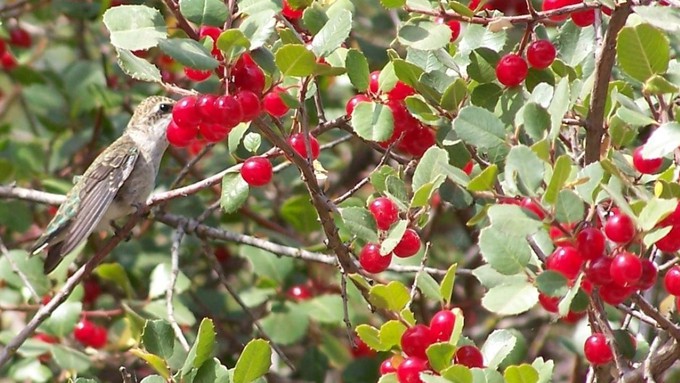
Learn how at free garden talks at all seven Green Acres

Hummingbirds like native plants, too. An Anna’s hummingbird pauses on a hollyleaf redberry in Sacramento to eat some insects. Photo courtesy Sacramento Valley CNPS
Pollinators make the world a more bountiful place; without them, we wouldn’t eat.
In addition to all those busy bees, favorite pollinators include butterflies and hummingbirds. While at work, these beneficial insects and active birds are fun to watch.
Learn how to invite more wildlife into your yard during free talks Saturday morning, June 17, at all Green Acres Nursery & Supply locations.
Set for 10 a.m. Saturday, “Grow a Butterfly and Hummingbird Garden” will cover the basics of how to plant a pollinator-friendly space for this summer’s visitors as well as how to attract more butterflies and hummingbirds for years ahead.
Plant the right flowers and they will come. Different species prefer to feed on specific plants.
According to the Sacramento Audubon Society, six species of hummingbirds may be seen in our region. They all love trumpet-shaped flowers, preferably in bright red or orange colors.
With emerald green feathers and a ruby-pink throat, Anna’s hummingbird is the most common – and a permanent Sacramento-area resident. Unlike most hummingbirds, Anna’s Hummingbird doesn’t migrate and is very territorial.
According to the Cornell Lab of Ornithology, Anna’s hummingbird is crazy about eucalyptus trees; the widespread planting of eucalyptus in California also spread the distribution of these tiny birds. In the wild, they feed on the nectar of manzanita, currant and gooseberry flowers but also go for lots of backyard plants. (Hummers also like to eat small bugs.)
Butterflies prefer flowers that offer a landing platform – some place to sit while they snack. Daisy-like flowers such as asters, coneflowers, lantanas and zinnias attract a wide range of butterflies but so do native plants such as California buckeye.
Some species demand certain plants for breeding. Monarchs must have milkweed. As their name implies, pipevine swallowtails lay their eggs on California pipevines. Purple passion flower vines host the Gulf fritillary. (Just remember: Butterfly host plants are grown to be eaten by caterpillars. So expect holes in the leaves!)
Find out who likes which flowers and a lot more during these information talks, which also provide an opportunity to get some local expert planting recommendations.
Green Acres nurseries are located in Sacramento, Auburn, Citrus Heights, Elk Grove, Folsom, Rocklin and Roseville.
For addresses and directions: https://idiggreenacres.com/.
Comments
0 comments have been posted.Sacramento Digs Gardening to your inbox.
Sites We Like
Garden Checklist for week of May 5
Survey your garden after the May 4 rainstorm. Heavy rain and gusty winds can break the neck of large flowers such as roses. Also:
* Keep an eye on new transplants or seedlings; they could take a pounding from the rain.
* Watch out for powdery mildew. Warmth following moist conditions can cause this fungal disease to “bloom,” too. If you see a leaf that looks like it’s dusted with powdered sugar, snip it off.
* After the storm, start setting out tomato transplants, but wait on the peppers and eggplants (they want warmer nights). Pinch off any flowers on new transplants to make them concentrate on establishing roots instead of setting premature fruit.
* Trim dead flowers but not leaves from spring-flowering bulbs such as daffodils and tulips. Those leaves gather energy to create next year's flowers. Also, give the bulbs a fertilizer boost after bloom.
* Pinch chrysanthemums back to 12 inches for fall flowers. Cut old stems to the ground.
* Mulch around plants to conserve moisture and control weeds.
* From seed, plant beans, beets, cantaloupes, carrots, corn, cucumbers, melons, pumpkins, radishes and squash.
* Plant onion sets.
* In the flower garden, plant seeds for asters, cosmos, celosia, marigolds, salvia, sunflowers and zinnias. Transplant petunias, zinnias, geraniums and other summer bloomers.
* Plant perennials and dahlia tubers for summer bloom.
* Don’t wait; plant summer bulbs, such as gladiolus and tuberous begonias.
* Harvest cabbage, lettuce, peas and green onions.